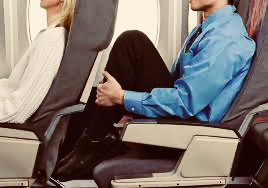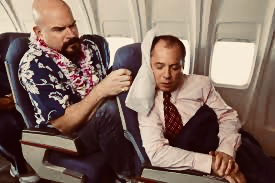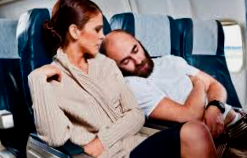Feeling Seatsick: Flying by the Seat of Our Pants.📌
Target: Malpractices, Malfeesance (Premise)
![]() Heaves, sweats, cramps, palpitations, hyperventilated panting: Such is the nature, the pressure and painfully close proximity of coach class air travel today.
Heaves, sweats, cramps, palpitations, hyperventilated panting: Such is the nature, the pressure and painfully close proximity of coach class air travel today.
Now the U.S. Federal Aviation Administration is just fine with that.
So too often, we must seat horn in by twisting, wedging and contorting no end before even beginning to buckle up. Then we squeeze and scrunch, play setback-atcha up to the knees in jam-packed cabins—shoot viral YouTube videos pitting agressive backseat pushback versus reclining rude.
Yet those airline seats continue decreasing in size as carriers take seat-mile and yield management to the max. Coach seats have generally shrunk some 1½ inches, been row configured 3 inches closer since the dawn of Deregulation in 1978. Though travelers (especially U.S.) haven’t been getting any slimmer.
Clearly the airline industry’s relentless profit drive and race to the bottom through capacity fiddling and route consolidation leaves them trafficking in passenger pain and discomfort, if not safety shortcuts. Meanwhile carriers squeeze higher-yield travelers more and more toward marginally roomier revenue gimmicks such as ‘premium economy’.
Still, the F.A.A. has just ruled that seat shrinkage poses “no immediate safety issue.” The agency cites its 90-second standard for evacuating planeloads in emergency situations, noting that seat size (width and pitch) is not a determinant in evacuation times, width and pitch “do not hamper the speed of evacuations”—indeed that larger seats would shave but a couple of seconds off evacuation results.
Fit to Sit?
The 90-second reference point appears to be test evacuation videos conducted by aircraft manufacturers (Boeing, Airbus, etc.), albeit in simulated cabin scenarios. Thus critics contend that such testing is contrived at best, and its scores do not truly represent an accurate safety baseline.
More specifically, some industry whistleblowers assert that plane builders edit and censor such tests, that they supply hand-picked crews. That test ‘passengers’ are actually airline employees prepped and practiced over and over, are pre-selected younger, fitter subjects with no bags, carry-ons, etc.. Nor are they elderly, howling infants, the handicapped or infirm. Essentially, this orderly (simulated) panic is rigged to beat the F.A.A. clock.
Contrast that with actual cell phone video of a 2016 emergency runway evacuation of an American Airlines 767 during an engine fiery takeoff from Chicago’s O’Hare Airport. Amid passenger screaming, shoving, struggling out of seats, they scramble in true panic mode down clotted aisles toward emergency exits. This ‘reality evacuation’ from a burning plane took over two minutes to fully execute.
Bottom line: once again the F.A.A. hews too closely to the air carriers’ line for comfort and safety, faithfully promoting airline industry interests—while we travelers are sitting ducks, inexorably feeling the squeeze. This becomes particularly crucial on ultralong nonstop flights (esp. in Boeing 767s and Airbus 350s), wherein passengers are already susceptible to cramping, fatigue, indigestion and dehydration aboard intercontinental trips lasting upwards of 20 hours.
Now Congress has weighed in on seat size in its recent FAA Authorization Bill, stipulating seat size and legroom minimums (detailed in our article on the bill), but we will see how, and how soon, the new rules are implemented.

Which is why Vamigré says that now more than ever, it’s high time to spread our collective wings…
